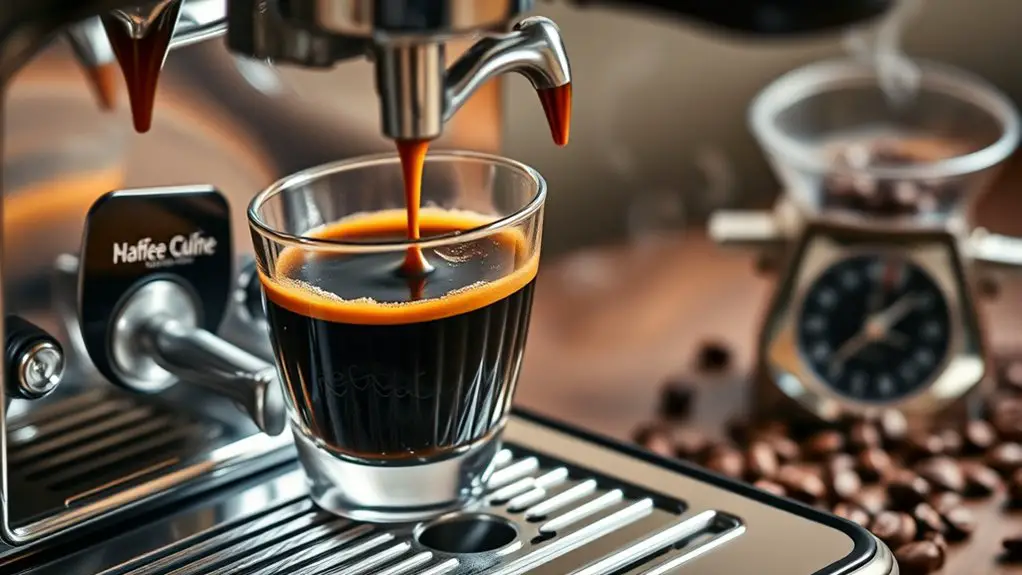Pressure is essential for espresso extraction in coffee machines. Ideally, it should be around 9 bars for the best results. Too little pressure leads to weak, sour shots, while too much causes bitterness. The right pressure guarantees uniform water flow through the coffee grounds, producing a balanced flavor profile. Regular checks and adjustments help maintain consistency. Mastering pressure can enhance your brewing skills and reveal unique flavor nuances, with more insights waiting to be uncovered.
The Role of Pressure in Espresso Extraction
When you brew espresso, the pressure you apply plays an essential role in the extraction process. Understanding pressure dynamics is vital for optimizing extraction efficiency. When you exert the right amount of pressure, you're ensuring that water flows through the coffee grounds uniformly, allowing for a balanced extraction of flavors and oils. Too little pressure may result in under-extraction, leaving your espresso weak and sour, while too much pressure can lead to over-extraction, creating bitterness. Each coffee type may respond differently to pressure changes, making experimentation key. By mastering the nuances of pressure application, you can reveal a world of flavor potential, achieving the freedom to create the perfect shot tailored to your palate.
Understanding Optimal Pressure Levels
Finding the right pressure level is key to achieving the best espresso extraction. Typically, ideal pressure hovers around 9 bars, but achieving this requires precise pressure calibration. Each coffee machine has its own nuances, and understanding these can help you maintain pressure consistency throughout the extraction process. If the pressure fluctuates, you risk under-extraction or over-extraction, compromising flavor and aroma. Regularly checking and adjusting your machine's pressure guarantees that you harness the full potential of your coffee beans. By focusing on consistent pressure during extraction, you empower yourself to craft a more balanced and flavorful espresso. Ultimately, mastering ideal pressure levels means you can enjoy the freedom of creating exquisite coffee drinks tailored to your taste. Additionally, high pressure can indicate blockages or clogs that may hinder optimal extraction.
How Pressure Influences Flavor Profiles
As you adjust the pressure during espresso extraction, you'll notice significant changes in the flavor profiles of your brew. A delicate balance in pressure influences flavor development, making it essential to understand how even slight variations can shift your cup's character.
| Pressure Level | Flavor Notes | Extraction Quality |
|---|---|---|
| Low | Mild, Fruity | Under-extracted |
| Ideal | Balanced, Rich | Well-extracted |
| High | Bitter, Overwhelming | Over-extracted |
Finding the right pressure balance allows you to highlight the nuances in your coffee, transforming each shot into a unique experience. By mastering pressure adjustments, you gain the freedom to explore a diverse range of flavors, ultimately enhancing your espresso journey.
Techniques for Controlling Pressure in Brewing
Understanding how pressure affects flavor profiles is just the beginning; mastering techniques for controlling that pressure is where the real artistry lies. One essential method is pressure calibration, ensuring your espresso machine delivers the desired pressure consistently. This involves regularly checking and adjusting your machine's settings to maintain ideal extraction.
Another technique is pressure profiling, which allows you to manipulate pressure throughout the brewing process. By gradually increasing or decreasing pressure, you can highlight different flavor notes in the coffee. Experimenting with these techniques lets you reveal a range of flavors tailored to your preference. Ultimately, controlling pressure not only enhances your brewing skills but also empowers you to craft the perfect cup, reflecting your unique taste.
Troubleshooting Pressure-Related Issues in Espresso Making
How can you identify and resolve pressure-related issues in espresso making? Recognizing pressure fluctuations is essential for a perfect shot. Here are a few steps to troubleshoot effectively:
- Check your pressure gauges: Verify they're functioning accurately; faulty gauges can mislead you.
- Inspect the pump: A malfunctioning pump may cause inadequate or excessive pressure.
- Examine the coffee grind: Coarser grinds can lead to low pressure, while overly fine grinds might create resistance.
- Evaluate the tamping technique: Uneven tamping can result in inconsistent pressure during extraction. Additionally, ensure the steam wand functionality is optimal, as it can impact overall pressure during the brewing process.
Frequently Asked Questions
Can Pressure Affect Caffeine Content in Espresso?
Yes, pressure can influence caffeine levels in espresso. By adjusting brewing variables like pressure, you can alter extraction rates, leading to variations in caffeine content, ultimately impacting the flavor and potency of your cup.
How Does Water Temperature Interact With Pressure During Extraction?
Water temperature markedly influences extraction efficiency; higher temperatures can enhance solubility, while lower temperatures might hinder it. When combined with pressure, these factors create a delicate balance essential for optimizing flavor and aroma in your espresso.
What Equipment Is Best for Consistent Pressure Control?
For consistent pressure control, look for espresso machines equipped with high-quality pressure regulators. These devices stabilize water pressure during extraction, ensuring uniformity and reliability, allowing you to achieve the perfect espresso every time without hassle.
Does Pressure Vary Based on Coffee Bean Type?
Sure, you'd think all beans would behave the same, but they don't. Bean density and roast level greatly influence pressure variation. Lighter roasts tend to create less resistance, altering extraction dynamics considerably. Enjoy the exploration!
How Do Different Brewing Methods Compare in Pressure Application?
Different brewing techniques apply varying pressure levels. Espresso machines use high pressure for extraction, while methods like pour-over rely on gravity. Understanding these differences helps you appreciate how each technique influences flavor and aroma in coffee.
